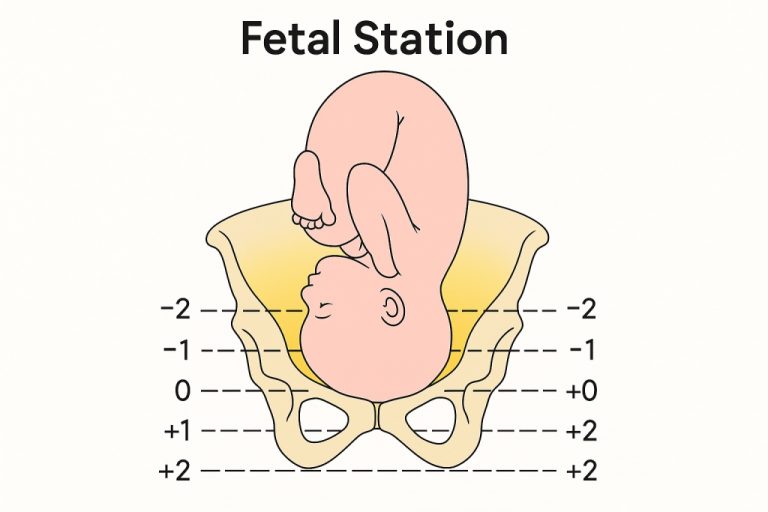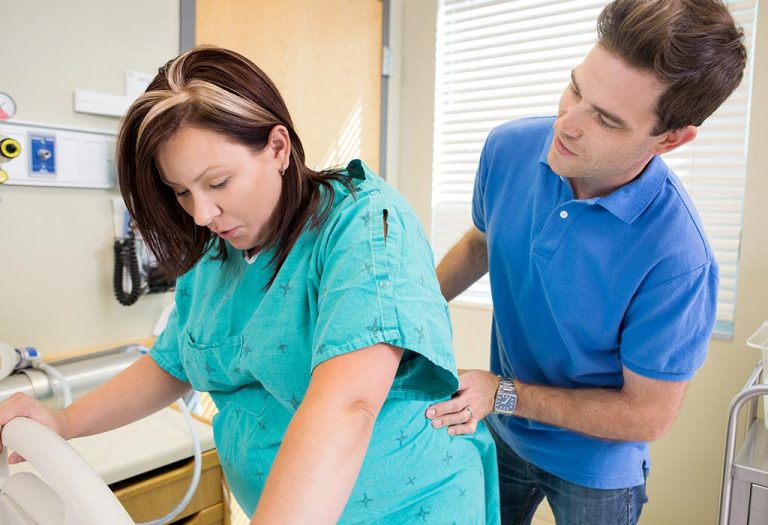Foetal Station During Labour & Delivery: Chart, Pros & Cons
- What Is Foetal Station?
- Importance of Fetal Station
- How Foetal Station Is Measured
- Foetal Station Chart
- Pros of Foetal Station
- Cons of Foetal Station
- How Is Fetal Station Related to Bishop Score?
- FAQs
As you progress in your pregnancy and you are closer to the date of delivery or your due date, you may come across the term ‘Foetal Station’ more often. Well, this term is used by doctors and midwives to check how far along your baby is making progress in the birthing canal during labour. The estimates range from -5 to +5, where 0 station means the head is aligned with your ischial spines. If you wish to know more about the fetal station, how it is measured, and whether there are any fetal station charts and other aspects of this topic, read below for more information.
What Is Foetal Station?
Foetal station or baby station is a term used to describe how far your baby has descended in your pelvis. The foetal station in labour is determined by establishing the relation between your baby’s head and your sit bones or ischial spine (1). The ischial spines or sit bones, which are approximately 3 to 4 centimetres inside your vagina, are used as a reference point for measuring the foetal station of the foetal head by your doctor (2). Your doctor will assign points ranging from 5 to -5 to tell where the baby’s head or ‘presenting part’, or the part that shows first during delivery (it is usually the head of the baby, but sometimes it can be toes or other parts, too), is located.
Importance of Fetal Station
The fetal station number is pivotal in charting the progression of labour. Doctors and midwives can track the progress of the baby by comparing the baby’s station from when the labour started to their current station progress.
Once the labour begins, some pregnant women may have a baby high in the pelvis with a station of -2. At the same time, others start labour where the baby is engaged at zero stations, with the baby staying lower in the pelvis.
“Coming down” of the baby means the fetal station during labour has changed, and the baby is moving further down the birth canal. It is a positive indication that delivery is getting close.
Fetal station measurement can change, so don’t get discouraged if it changes quickly. As an alternative, you can take care of your birth plan and practice preferred pain management techniques.
How Foetal Station Is Measured
Here is how your doctor can help in determining or measuring foetal station:
- Your doctor uses a determining point in your pelvis, which is your ischial spines, to establish the location of your baby’s presenting part or foetal station during labour.
- This landmark point or determining factor helps your doctor to know how far your baby has come down or descended into your pelvis. This means that your doctor uses this point to establish whether the baby is in a floating position, head above the pelvis, fully engaged, beginning to the crown, or crowning.
- The foetal station is measured in centimetres with ischial spines as the reference line, and it is measured 5 centimetres above and 5 centimetres below this reference line. However, the foetal station is measured in numbers ranging from 5 to -5 numbers and not in centimetres.
- Your foetal station measurement is a great indicator for your doctor or health care provider to start preparing for the birthing process or delivery.

Foetal Station Chart
The foetal station chart is an important parameter to ascertain the progress of the baby through the birth canal, and most gynaecologists use this as an important tool to avoid the use of forceps during the delivery until or unless the baby has made considerable progress in the pelvis. Where most doctors establish foetal head stations in pregnancy on a scale of 5 to -5, there are some doctors who may use a 3 to -3 scale, too. The following chart showcases the basic landmarks used for describing the fetal station (3):
| The Score | What Does It Mean |
| The score is between -5 to 0 | Also known as floating, the baby’s ‘presenting part’ is above the ischial spine at this stage. In some cases, the doctor may not feel the presenting part at this stage. |
| The zero station | At this stage, the baby’s head is aligned or engaged in the ischial spines. |
| The score is between 0 to 5 | When the score becomes positive, it indicates that the baby has descended further into the pelvis and beyond the ischial spines. |
The difference in numbers is in centimetres. For example, the difference between 5 and 4 or -5 and -4 is 1 centimetre and so on.
It is also important to note here that the foetal station and bishop score are very important parameters to help the doctor ascertain how well the labour is progressing. The foetal station is an integral part of counting bishop score, which helps the doctor in determining whether you will have a vaginal birth or a cesarean delivery. Apart from the foetal station, dilation, effacement of the cervix, consistency of the cervix, and baby’s position are important components in calculating the bishop’s score. Different points are assigned to these factor,s and your doctor calculates the points to see if you are a fit candidate for vaginal delivery or not. A score of 8 or higher is a good indicator, whereas 3 or less means vaginal delivery is quite unlikely.
Pros of Foetal Station
The foetal station is an important factor and is beneficial to the doctors to check how well your labour is progressing. Here are some pros of measuring foetal station:
- The foetal station is determined by conducting a cervical examination, which is not only a fast procedure but also painless for the pregnant woman.
- This is one of the safest and most convenient ways for establishing how far the baby has reached down the birthing canal and also one of the most widely popular methods for establishing foetal station and engagement.
- Your doctor may alternatively use imaging tools such as an ultrasound machine to establish your baby’s position in your pelvis. This method is also as effective as cervical examination to establish the foetal position (4).

Cons of Foetal Station
Apart from the various pros of measuring foetal station, there are certain drawbacks of this procedure that should not be overlooked. The following are some cons of measuring foetal station:
- The results may not be accurate, and sometimes different doctors may come up with different results.
- Every doctor may use different measurements or subjective measurements for establishing foetal station according to where they think the ischial spines are.
- The doctor may want to conduct frequent vaginal exams during labour to measure the foetal station. This may increase the chances of vaginal infection or other kinds of infections (5).
- The pelvis appearance can be different in some women, which means some women may have a shorter pelvis, which may make the judgment of foetal station difficult or complex for the doctor.
- Sometimes, the shape of the baby’s head may make the doctor think that the baby is further down in the birthing canal, but that may not be the case.
How Is Fetal Station Related to Bishop Score?
The fetal station is a part of the Bishop score. Health experts employ the Bishop score to determine the outcome of labour induction and the likelihood of vaginal delivery or the necessity of cesarean delivery.
Here are some aspects of a Bishop score (6):
- Dilation: Doctors evaluate dilation in centimetres and how much the cervix has widened for labour.
- Position: It also evaluates the position of the baby.
- Effacement: It is the thinning and shortening of the cervix and is measured in percentage (7).
- Station: It refers to the position of the baby’s head in relation to the mother’s pelvis, relative to the ischial spines. The higher the station, the lower the baby is in the pelvis.
- Consistency: It refers to the consistency of the cervix—the softer the cervix, the closer the delivery.
If a Bishop score is less than 3, it means that you may need some form of induction to induce labour and contractions. If it is higher than 8, it means there are chances of delivery spontaneously.
Here is how doctors evaluate the score:
| Score | Cervix dilation | Cervix effacement | Fetal station | Cervix position | Cervix consistency |
| 0 | closed | 0% to 30% | -3 | posterior | firm |
| 1 | 1-2 cm | 4% to 50% | -2 | mid-position | moderately firm |
| 2 | 3-4 cm | 60% to 70% | -1 | anterior | soft |
| 3 | 5+ cm | 80% or greater | +1 | anterior | soft |
FAQs
1. What is the purpose of fetal station measurement?
Doctors measure the fetal station to understand the progress of labour. Additional assessments your doctor might consider are cervical dilation, which refers to the extent of your cervix’s enlargement to facilitate your baby’s passage, and cervical effacement, which indicates how much thinner your cervix has become to aid in delivery. Suppose a baby is not advancing through the cervix over time. In that case, a physician may need to contemplate delivery via cesarean section or with assistance from tools like forceps or a vacuum.
2. What is the association of the fetal station with delivery?
The fetal station in pregnancy is inversely proportional to delivery. The higher the foetal station, the farther the likeliness of delivery. Similarly, the lower the fetal station, the closer the likelihood of the delivery of the baby.
3. Are there any chances of a baby moving back up in the fetal station?
Although rare, the chances of the baby moving slightly higher in the fetal station are due to the changes in the baby’s position, contractions, or excessive pushing before full dilation.
There is no doubt that foetal station measurement is one of the important parameters in helping the doctor determine how successful your labour is. Other considerations that your doctor may look into are your cervical dilation or how enlarged your cervical opening is. If your doctor thinks that the labour is not progressing as expected or there are any other probable complications, your doctor may either go in for a vacuum or forceps delivery option. And in some cases where none of these methods may be useful, the doctor may suggest cesarean delivery.
Foetal station measurement is a term that you may not hear until the last few weeks of your pregnancy, or in some cases, women may come to know about this term during labour only. When you are in labour, your foetal station measurement may help your doctor know how well the progression of labour is happening. Your labour can start even if your baby is high in your pelvis. For example, at station -2, but for other women, labour may begin at station 0, which means that the baby has engaged in the pelvis or even lower than that. Positive numbers in the foetal station can be an indication that you are closer to delivery or giving birth. Also, the station starts changing as soon as you start pushing during the labour.
It wouldn’t be wrong to say that foetal station measurements can vary slightly from one doctor to another, which means that results can be imprecise. However, most doctors use this tool effectively to know about labour progression. You can get in touch with your doctor if you have any more concerns regarding the foetal station.
Also Read:
Stages of Labour & Childbirth
Interventions during Labour and Childbirth
Positions to Try during Labour and Childbirth
Foetal Growth Chart Week by Week – Length & Weight
Was This Article Helpful?
Parenting is a huge responsibility, for you as a caregiver, but also for us as a parenting content platform. We understand that and take our responsibility of creating credible content seriously. FirstCry Parenting articles are written and published only after extensive research using factually sound references to deliver quality content that is accurate, validated by experts, and completely reliable. To understand how we go about creating content that is credible, read our editorial policy here.























